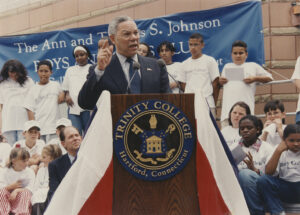Reflecting on the 20th Anniversary of the Learning Corridor
The Learning Corridor opened in 2000, just over twenty years ago. Spearheaded by the Southside Institutions Neighborhood Alliance (SINA) and Trinity College, the Learning Corridor brought together the Trinity College Boys and Girls Club and four schools – the Hartford Montessori School, Greater Hartford Academy of the Arts, Greater Hartford Academy of Math and Science, and Hartford Magnet Middle School (which would become Hartford Magnet Trinity College Academy – or HMTCA – in 2011). As Trinity prepared to enter the 21st century, the College considered questions about how to be a good neighbor and partner to the community while preparing students to be well-informed global citizens. Part of the response to these questions was to take a leading role in the development of the Learning Corridor. Trinity hoped to use the value of education as a “medium for community and institutional change.”¹

The Learning Corridor was an ambitious project that combined ideas about Trinity College’s role as a major part of the urban landscape in Hartford and responses to school desegregation at that moment.

The development of the Learning Corridor included remediation of a Connecticut Transit bus garage brownfield site and the demolition of several other residential and commercial buildings. This displacement raised some debate in the media about what the project would mean for the mostly Puerto Rican and other Latino residents that lived nearby. The development of the Learning Corridor on the former site of a bus garage is a tangible sign and symbol of the movement from the infrastructure-oriented urban development of the past to the educational and medical institution (“eds and meds”) urban economy of today.
Nearly a decade after the opening of the Learning Corridor, Hartford Public Schools (HPS) and Trinity College leaders proposed to expand HMMS from a middle school to also include an early college preparatory high school. HPS and Trinity signed a formal agreement in 2011 that created the Hartford Magnet Trinity College Academy (HMTCA). The agreement created an early college program that included summer writing and science programs, use of classroom space at Trinity, and the possibility for HMTCA students to take introductory Trinity courses.

In 2019, HPS and Trinity College updated the agreement for the partnership. While still focusing on the early college program model, the agreement also focuses on issues of educational equity, including academic enrichment, student leadership, and multicultural/multilingual learning that brings Trinity and HMTCA communities together. These ideas were based on responses from a community-engaged study conducted with students, teachers, faculty, and alumni in 2018-19.²
The 2018-2019 HMTCA study pointed to positive outcomes of the partnership. HMTCA students feel more comfortable navigating college campuses and feel more prepared for college level work. Moreover the Learning Corridor has had implications for neighborhood economic development. SINA reports that homes located adjacent to the Learning Corridor are highly desirable because of their location near the school campuses.³
The 20th anniversary of the Learning Corridor offers the opportunity to reflect back on the project’s successes and shortcomings, as well as identifying further opportunities for partnership. Trinity College students, faculty, and staff have written numerous pieces on the Learning Corridor’s history and impact. Learn more through their writing:
- HMTCA-Trinity Partnership Evaluation
- Latino Politicians, Activists, and Parents: The Challenge of Implementing City-Suburban Magnet Schools. By Nivia Nieves ‘05 and Jack Dougherty
- Shaping the Learning Corridor Interdistrict Magnet Schools, 1990s to the Present by Nivia Nieves ‘05
- Trinity College in the Twentieth Century: A History by Peter Knapp and Anne Knapp (Chapter 7

The silhouette of the Learning Corridor takes shape on Broad Street. 1999. Photo courtesy of the Watkinson Library at Trinity College. Photographer unknown. addresses the Learning Corridor)
- Trinity College and The Learning Corridor: A Small, Urban Liberal Arts College Launches a Public Magnet School Campus by Kevin B. Sullivan and James A. Trostle
- In the Shadow of the Ivory Tower: How Universities are Plundering our Cities by Davarian Baldwin (Chapter 2 addresses the Learning Corridor)
1 The Office of Community and Institutional Relations and the Dean’s Office, Trinity College. Report to the Office of Higher Education and the Office of Neighborhood and Community Development at the W.K. Kellogg Foundation. “Education in the 21st Century. An Implementation Project for The Learning Corridor of Trinity College.” April 1997.
2 HMTCA-Trinity Partnership Evaluation. https://cher.trincoll.edu/hmtca-trinity-evaluation/
3 Iaiennaro, Dean. Director of Real Estate Development at SINA. Conversation with author. March 2020.
